Think back over the past 24 hours of your life; how many hours — or even minutes — of that time were you engaged with a mobile device? If you said none, you are in the minority. Statistics from several mobile industry reports say 64% of U.S. adults own a smartphone (Pew), 54% use mobile over computers to search the web and view videos (eMarketer), and 46% of smartphone owners say their smartphone is something “they couldn’t live without" (Pew). These are all very good reasons why pharma marketers plan to increase their spend on digital to $1.93 billion this year. They aim to leverage the consumer data collection available through these devices, as well as tap into digital savvy consumers who use their mobile device to search for answers to healthcare issues. Sure, it’s a lot less than other industries are investing in digital advertising, but signs point to pharma slowly inching forward in its commitment to integrating digital into marketing plans.
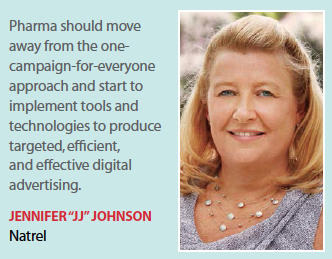 “Data-driven customization and personalization of digital advertising is the norm in industries other than pharma, and a wide variety of tools and technologies are used to assist in not only the data collection part of the process, but also in the analysis and management of the advertising," says Jennifer “JJ" Johnson, senior VP, director channel strategy, at Natrel. “Pharma companies need to move away from the one-campaign-for-everyone approach and implement the same type of tools and technologies being used elsewhere to produce truly targeted, efficient, and effective digital advertising."
“Data-driven customization and personalization of digital advertising is the norm in industries other than pharma, and a wide variety of tools and technologies are used to assist in not only the data collection part of the process, but also in the analysis and management of the advertising," says Jennifer “JJ" Johnson, senior VP, director channel strategy, at Natrel. “Pharma companies need to move away from the one-campaign-for-everyone approach and implement the same type of tools and technologies being used elsewhere to produce truly targeted, efficient, and effective digital advertising."
According to an eMarketer report, The US Healthcare and Pharma Industry 2016: Digital Ad Spending Forecast and Trends, digital ad spending in the healthcare and pharma category will reach $3.10 billion annually by 2020. Growth rates in the healthcare and pharma category will increase steadily, representing a compound annual growth rate of 13.2% from 2015 to 2020. This is comparable with the consumer packaged goods and automotive sectors, and higher than the U.S. digital ad spending growth rate of 12%.
eMarketer also predicts that in 2017, overall total digital ad spending will surpass TV ad spending for the first time. TV is expected to be $72.01 billion, or 35.8% of total media ad spending in the United States and digital is anticipated to be $77.37 billion, or 38.4% of total ad spending. However, this will not hold true in the pharma industry.
“While other industries are spending more on digital than television, that’s not the case in pharma," says Maryann Kuzel, senior VP, head of healthcare strategy, North America, RAPP. “The percentage of total spending in pharma is still much lower, but it’s growing at about the same rate as the general consumer space."
According to Ms. Kuzel, the average pharma company is spending 11% of its budget on digital advertising, ranging from 22% for some companies to 2% for others.
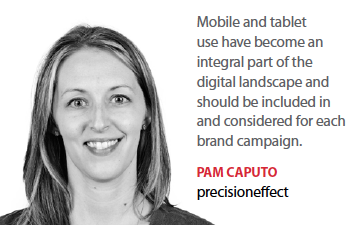 Two factors are attributed to driving the industry’s increased attention toward digital advertising. First, digital is where most of the consumers are — both physicians and patients — and second, the focus on rare diseases in R&D is creating more opportunities for niche groups, which will require hyper-targeted messaging through digital outlets.
Two factors are attributed to driving the industry’s increased attention toward digital advertising. First, digital is where most of the consumers are — both physicians and patients — and second, the focus on rare diseases in R&D is creating more opportunities for niche groups, which will require hyper-targeted messaging through digital outlets.
“The industry has been talking about digital for a long time, and I think we’re now at a tipping point; digital tactics have been used for long enough now that pharma companies should have a level of comfort," Ms. Kuzel says. “We’re certainly at a digital tipping point in terms of how audiences are engaging with media and companies, whether those audiences are consumers or physicians. Pharma companies have to change their strategies to be effective in their marketing efforts."
“The fundamental shift in the digital competence of consumers is going to put pharma CRM managers on CPR," says Jeremy Schwartz, director of engagement strategy and analytics, AbelsonTaylor. “Today, the key reason that pharma companies use broadcast media is reach. But when a typical consumer looks to Facebook seven times each day, the need for reach by broadcast goes down dramatically."
This is particularly important in the case of some disease states, such as bipolar disorder, incontinence, ADHD, or even acne.
“In the coming years, the ability to use Facebook IDs to capture and promote to patients who have not self-identified with having a disease will become more and more important," Mr. Schwartz says. “This will change pharma customer relationship management."
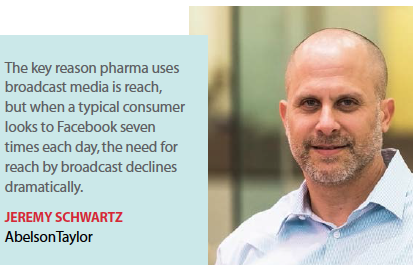 According to Caleb Freeman, director, search and digital media, Calcium, the go-to channels of the past may start to take a back seat to new digital channels. New channels and virtual realities are popping up every day, and with them new and unique contexts and nuances in which marketers must be active. Distributing a consistent and relevant message within traditional channels only gets more challenging as these changes accelerate.
According to Caleb Freeman, director, search and digital media, Calcium, the go-to channels of the past may start to take a back seat to new digital channels. New channels and virtual realities are popping up every day, and with them new and unique contexts and nuances in which marketers must be active. Distributing a consistent and relevant message within traditional channels only gets more challenging as these changes accelerate.
“Patients are empowered by low-cost, distributed communication channels; they also have access to an incredible amount of both accurate information and harmful misinformation," he says. “The free flow of information allows niche communities to form that otherwise would be impossible, such as cystic fibrosis, where patients aren’t allowed to be in physical contact with one another." (People with cystic fibrosis carry bacteria within their lungs that could be harmful to other patients.)
Reaching Specialty Patient Populations
The advent of personalized medicine and the increasing focus on rare disease therapies is creating a climate that will encourage more pharma digital spend.
“There are about 300 specialty medicines on the market today and another 700 in development, which is expected to account for more than half of pharmaceutical sales by 2018," Ms. Kuzel says. “Marketers will need to use precision targeted messaging instead of mass marketing to get the right therapy messages to the right patients and they will need laser-sharp accuracy. With the new tools, such as smart data, predictive analytics, and more addressable forms of media, especially digital, available, we should start to see an increase in digital advertising spending."
Any manufacturer with a rare disease therapy in its pipeline will want to invest in digital advertising to reach these small patient groups.
“Both large and small pharma companies are spending more of their R&D budgets on these new breakthrough categories, many of which are targeting orphan diseases or smaller subsets of chronic conditions," Ms. Kuzel says.
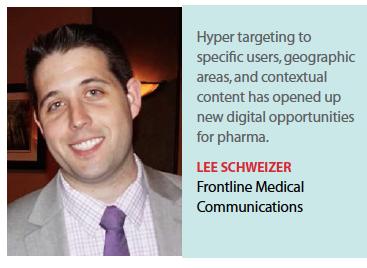 Several other developments have opened up new digital opportunities for pharma, according to Lee Schweizer, VP, e-business development, Frontline Medical Communications, including hyper-targeting to specific users, geographic areas, and contextual content.
Several other developments have opened up new digital opportunities for pharma, according to Lee Schweizer, VP, e-business development, Frontline Medical Communications, including hyper-targeting to specific users, geographic areas, and contextual content.
“These tools are evolving along with data management platforms that improve data collection and analysis," he says. “We fully expect a transition to combination targeting — User X on page X — in other words, the best of both worlds."
Another opportunity lies in HCP-level user/engagement data, which allows advertisers the ability to track prescription writing for singular campaigns. Many publishers make this available, and in some cases it is required. Reaching physicians through programmatic buying is also available, if publishers are open to the concept. According to Mr. Schweizer, a recent Association of Medical Media panel noted that programmatic buys represent about 5% of HCP digital spending, so there is still plenty of room for growth.
However, he cautions marketers not to go targeting crazy, as valued physicians may be overlooked. Advertisers should consider other dynamics, such as specific behaviors, to address their target audience.
“Even though targeting is a great advancement and something that should be capitalized on, it has created a narrow-minded approach," he says.
Traditional and Digital Strategy Integration
As the industry begins to use more digital channels in its marketing efforts, the delineation between traditional marketing and digital marketing should fade.
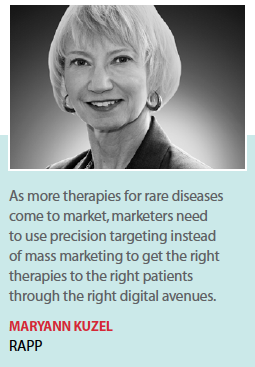 Mr. Freeman from Calcium says pharma marketers need to shake their decades-old strategies and realize that the lines between digital and non-digital are becoming more blurred every day.
Mr. Freeman from Calcium says pharma marketers need to shake their decades-old strategies and realize that the lines between digital and non-digital are becoming more blurred every day.
“Pharma marketers continue to view the world as digital and nondigital with a big immoveable firewall in between, however, digital advertising is simply advertising, social media and search are simply different channels with their own context and nuances just like TV and in-office marketing," he says.
Mr. Freeman encourages marketers to start with the basics: TV and Web assets must work together under a cohesive marketing strategy. They cannot be separate initiatives.
“The key to overcoming integration issues is to stop thinking in terms of ‘traditional’ and ‘digital’ and instead think in terms of holistic marketing that focuses on improving patient outcomes," he adds.
According to Ms. Johnson at Natrel, pharma marketers still struggle with integrated channel planning.
“Rarely is a complete marketing ecosystem that includes both online and offline touchpoints developed, let alone executed," she says. “Many brand marketers still treat traditional and digital marketing channels as silos, even going so far as having separate agencies responsible for digital and traditional marketing."
Ms. Johnson says this approach creates an us-versus-them atmosphere in which the channels are competing for inclusion and, of course, marketing dollars, and that is just the opposite of what’s needed.
“Online and offline touch points must be connected and work in concert to provide a cohesive target audience journey and meet the objectives of the brand," she says.
“Mobile and tablet use have become an integral part of the digital landscape and should be included in, and considered, for each campaign," says Pam Caputo, senior media strategist, precisioneffect. “Marketers need to consider how this type of targeting differs from display to mobile, as well as how the creative translates on mobile, for example what size ads should be incorporated and what will the mobile KPI be."
However, in some cases, such as with medical journals, a digital component may not be available or as viable. According to several research reports, print journals still hold an affinity and an important place in the physicians’ world.
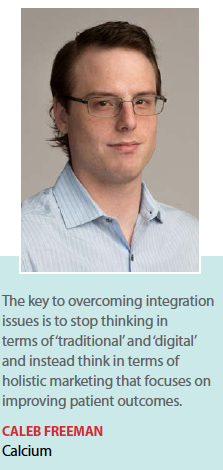 “In the pharma space there are strong journals that carry a weight that hasn’t fully transferred itself to the digital space," Ms. Caputo says. “The online sites for journals are getting better, but don’t often have the same content or digital capabilities that a typical commercial site might have. While digital will continue to play more and more of a role, it may not be through journal sites but rather with the MD Linx, Medscapes, and Epocrates. These sites aggregate journal content may continue to take more of the dollar share of media spend in the near future."
“In the pharma space there are strong journals that carry a weight that hasn’t fully transferred itself to the digital space," Ms. Caputo says. “The online sites for journals are getting better, but don’t often have the same content or digital capabilities that a typical commercial site might have. While digital will continue to play more and more of a role, it may not be through journal sites but rather with the MD Linx, Medscapes, and Epocrates. These sites aggregate journal content may continue to take more of the dollar share of media spend in the near future."
Mr. Schweizer agrees that print is still held in high regard, but he predicts a future where digital initiatives will exceed those of print, because digital can show a much clearer picture and even provide a direct correlation to script writing lift, he says. “Print will always have a place, but the ability to evaluate ROI should eventually result in digital surpassing print," he says. “The issue today is that pharma companies don’t seem to understand digital metrics and would rather invest in a media channel that has decades of history."
Challenges In Digital
The greatest hurdle in digital advertising — as in all pharmaceutical advertising — is the paralysis that comes with the fear of being out of compliance. The second biggest hurdle is the lack of time in the marketing cycle to test and incubate a campaign. Brands are short on time but long on financial resources, so tried-and-true methods are primed to receive large amounts of funding and churn out mediocre, but predictable results. The incentive to stick to the safety of the well-beaten path can be insurmountable.
“The biggest misstep clients and agencies often make is to skew too conservatively in their approach, often pinning undue blame on regulatory restrictions when in reality it’s a discomfort with trying something new that drives the recurrent embrace of overly conservative strategies," Mr. Freeman says. “Pharma companies should own the digital turf."
By taking the safe road, brands are missing out on the greatest opportunities in healthcare, and, in doing so, are allowing companies in other industries to reap the rewards, for example, Google, Apple, and other Silicon Valley companies that are creating inroads into healthcare, he says. This practice of playing it safe detracts significantly from the focus on the ultimate goal of all healthcare, which is to create better patient outcomes.
“In short, the major misstep that the industry is making is not taking a calculated risk," Mr. Freeman says. “When it comes to digital, pharma companies are playing it very safe, too safe to be effective in many cases. It’s important that pharma marketers guard against being overly conservative and adopt a mindset that, while considering the regulatory risks, is much more concerned about how to leverage resources that meaningfully advance patient outcomes."
There are many more ways to use digital than posting a digital banner ad. Apps can be created to help patients manage their conditions; non-branded content can educate and mitigate misinformation; peer-to-peer networks and representatives within social media can support patients and physicians; and IoT applications can provide meaningful data for better decision making.
“These digital avenues present incredible opportunities for brands to not just form meaningful relationships with patients but to remove obstacles on the path to better health and truly recreate the patient experience," Mr. Freeman says. “As daunting as some of these opportunities may sound, they don’t necessarily introduce high levels of regulatory risk. Most simply require a will to learn the nuances of something new and different."
Regulatory review teams are also leery of programmatic advertising. While other industries spend about 50% of their digital budget on programmatic ads, the pharma industry is closer to 25%, Ms. Kuzel says. Low inventory and a higher cost in the pharma sector may be one reason for the lag, but Ms. Kuzel believes it is more the fear of where the ad will be placed.
“A lack of control is one of the big barriers keeping the industry from increasing its digital presence and using digital in an efficient way," she says. “Another myth plaguing the industry is that baby boomers — pharma’s marketing sweet spot — are not online, but digital advertising can in fact be very effective in reaching this audience."
Digital can also be effective in creating a space for facilitating better doctor-patient conversations, especially when consumers can be overwhelmed with the numerous educational materials on the market today. Many turn to their physicians for clear guidance. To set the stage for more informed and productive patient-doctor conversations, pharma marketers should make HCPs aware of how their brands are being marketed to consumers as well as the patient resources they provide. Doctors who know what patients are seeing can address a particular program and are better equipped to answer questions about that specific treatment option. And patients are much more likely to leave their appointments believing that their physicians heard them, understood their issues, and delivered the right solution.
“The doctor-patient conversation has never been more important," Mr. Schwartz says. “And the pharma industry is missing the mark on connecting these two audiences at critical times."
Our experts say it has become necessary for pharma companies to move beyond the traditional channels of print and sales and develop a comprehensive channel ecosystem that engages all possible audience touchpoints. Digital plays a major role in the world of the pharmaceutical industry’s target audiences, and companies need to become comfortable in this world.
“The pharma industry does a lot of talking about responsive, multichannel customer engagement, but the actual doing part falls short," Ms. Johnson says. “There is still a place for the traditional channels, but digital must be given equal, if not priority, consideration when developing a customer-centric multichannel strategy." (PV)


















